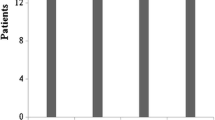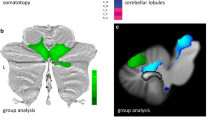Summary
The severity of Friedreich's ataxia was graded in ten patients by clinical examination and in five by use of posturography. These data were compared with neuroradiology findings. CT-confirmed infratentorial atrophy occured only in advanced cases of Friedreich's ataxia; the correlation with the clinical score was poor. On mid-sagittal MRI planes the diameters of fourth ventricle, brain stem at the level of the inferior olive and spinal cord at the levels of the foramen magnum and C3 were measured. Patients with Friedreich's ataxia had significant MRI-confirmed atrophy of the cranial spinal cord as compared with a normal, age-matched control group. This was also observed in patients with Friedreich's ataxia in the early stages. A reliable correlation between atrophy of the cranial spinal cord and the clinical score, however, could again not be found. MRI exploration of the cranial spinal cord may be recommended as an additional diagnostic marker in Friedreich's ataxia.
Similar content being viewed by others
References
Claus D, Aschoff JC (1982) Evaluation of infratentorial atrophy by computed tomography. J Neurol Neurosurg Psychiatry 45:979–983
Diener HC, Dichgans J, Bacher M, Gompf B (1984) Quantification of postural sway in normals and patients with cerebellar diseases. Electroencephalogr Clin Neurophysiol 57:134–142
Diener HC, Müller A, Thron A, Poremba M, Dichgans J, Rapp H (1986) Correlation of clinical signs with CT findings in patients with cerebellar disease. J Neurol 233:5–12
Einsiedel H, Stepan R (1985) Magnetic resonance imaging of spinal cord syndromes. Eur J Radiol 5:127–132
Gawehn J, Schroth G, Thron A (1986) The value of paraxial slices in MR-imaging of spinal cord disease. Neuroradiology 28:347–350
Geoffroy G, Barbeau A, Breton G, Lemieux B, Aube M, Leger C, Bouchard JP (1976) Clinical description and roentgenologic evaluations of patients with Friedreich's ataxia. Can J Neurol Sci 3:279–286
Greenfield JG (1954) The spinocerebellar degenerations. Blackwell, Oxford
Harding AE (1984) The hereditary ataxias and related disorders. Churchill Livingstone, Edinburgh
Kurtzke JF (1955) A new scale for evaluating disability in multiple sclerosis. Neurology 5:580–583
Kurtzke JF (1965) Further notes on disability evaluation in multiple sclerosis with scale modifications. Neurology 15:654–661
Lamarche JB, Lemieux B, Lieu HB (1984) The neuropathology of “typical” Friedreich's ataxia in Quebec. Can J Neurol Sci 11:592–600
Oppenheimer DR (1979) Brain lesions in Friedreich's ataxia. Can J Neurol Sci 6:173–176
Werdelin L (1986) Hereditary ataxias. Acta Neurol Scand 106[Suppl]:1–124
Wessel K, Diener HC, Dichgangs J (1988) Long loop reflexes and postural ataxia: follow up study with and without treatment by 5-HT in patients with Friedreich's ataxia. In: Amblard B, Berthoz A, Clarac F (eds) Posture and gait, development, adaptation and modulation. Excerpta Medica, Amsterdam, pp 237–244
Wessel K, Diener HC, Dichgans J, Thron A (1988) Cerebellar dysfunction in patients with bronchogenic carcinoma: clinical and posturographic findings. J Neurol 235:290–296
Young IR, Randell CP, Kaplan PW, James A, Bydder GM, Steiner RE (1983) Nuclear magnetic resonance (NMR) imaging in white matter disease of the brain using spin-echosequences. J Comput Assist Tomogr 7:290–294
Author information
Authors and Affiliations
Additional information
The study was done at the Department of Neurology, University of Tübingen.
Department of Neuroradiology, University of Mainz; guest at the Department of Neuroradiology, University of Tübingen, during the study.
Rights and permissions
About this article
Cite this article
Wessell, K., Schroth, G., Diener, H.C. et al. Significance of MRI-confirmed atrophy of the cranial spinal cord in Friedreich's ataxia. Eur Arch Psychiatr Neurol Sci 238, 225–230 (1989). https://doi.org/10.1007/BF00381470
Received:
Issue Date:
DOI: https://doi.org/10.1007/BF00381470




